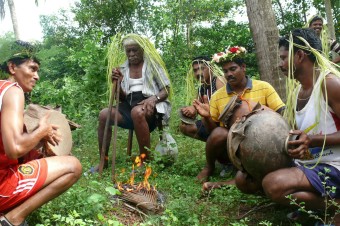The Explosion of Monsoon Life
The last time a blue whale was sighted off the coast of Sindhudurg, tadalafil it was 1914.
Between March and May this year, scientists doing a study on cetaceans saw a mother and calf 2.7 kms from the shore. Which means they’d been hovering around Goa, too, through the first half of the year. Considering it’s a rare phenomenon, one might have expected headlines in the local newspapers. But NaMo proved to be a bigger draw than the biggest mammal on the planet visiting the neighbourhood. I’m hoping to see those whales somewhere in the sea, sometime this monsoon.
That event prompted me to ask my Facebook friends (I’ve more in number in the virtual than the real world) which creatures reveal themselves to us in the monsoons.
In my own home, the quick-moving little red frogs with the yellow and black markings leap out of crevices and cracks, scaring me out of my wits at any time, 24×7. More often at night and in the middle of sleepy summer afternoons. They and their green, sluggish cousins startle rather than scare me. Other than cockroaches (the very name, Periplanata americana, suggests they are/were imported), I’m not afraid of most creatures of the night. Not even of the lizards that eat them alive.
The small bebos, big bebooks, and chanchads of the frog and toad families croak away through the wet months of Shravan and Bhadrapad, sometimes right till Diwali is over. Popularisation of their legs in some recipes have decimated their numbers, hopefully the long arm of the Law will improve that situation.
My Facebook friends made a long list: the most popular keeda (literally insect, but the term is used for worms and aphids, too) turned out to be the millipede (gothayn in Konkanni). That’s probably because both varieties, small and smaller, come in hordes/swarms and make moving carpets on the floor and go scrunch if you step on them; and give out a horrid stink. But, unlike the majestic red centipedes (local waghoni), at least they don’t bite painfully.
Leave the lights on in the dark and doors and panes open, and you invite clouds of ‘flying ants’. Mosquitoes and crickets as well, but these ‘ants’ kill themselves and in the morning one can sweep away a hundred or so corpses per bulb or window/door left open. The konkanni word for ant is muyee (plural muyo) and a black variety of these ants have a musical name: kalyo hulhulyo muyo.

With urbanisation and loss of forest cover, some interesting insects have become nearly extinct. Like the fireflies or kazuley. If one wants to see them now, one needs to visit neglected graveyards, I’m told.
The highly avoidable kusa keed gets its local English name ‘blanket worm’ because it has a furry/hairy cover. Touch it and you’ll be itchy and scratchy for several hours. Those hairs are fine and cause simple but uncomfortable allergies.
In our plot, the ground seems to come alive and move after the first rains. The gaandool or earthworm or ‘farmers’ friends’ do their job of aerating the soil, around the roots of trees big and small. On the branches above, fellow-helpers the kaatmuyo or fire-ants scurry around stitching nests with big leaves.
We humans check our gumboots each time we have to wear them because this is also the season for the scorpions to find their mates and start families. Why they choose our footwear I don’t know.
Snakes: some of them are poisonous, true, friends have lost curious pet dogs to vipers and cobras. But most, like the green tree snake and the rat-snakes and the sand-boas, should be spared the rod, for they (in Konkanni the evali, malun, nannatoto, haryali) help control the rodent population.

Even in abodes away from the sea, people catch crabs in their fields and yards. The little scurrying ones have no flesh, but I’m told that when cooked the stock can be added to curry. I haven’t tried it, but what I have tried is chasing them around aimlessly. Hoping it helps keep the calories burning. Certainly amuses the neighbours.
This is the season to eat snail-xacuti. And wild-mushroom sukkey. No fish. Well, only frozen or dried, not freshly-caught.
Quite often, the presence of some of the keedas (like the chaanchad that creep out of the floor in droves) are an indication that the monsoon clouds will come within the week.
Some monsoon visitors are invisible: viruses that infect the throats, bacteria that irritate the intestine and fungi that attack the skin.

We humans have a choice. We can moan the gloom and the creatures that come with it. Or we can rejoice in the life-giving season and be curious. With the keedas come the birds and the butterflies, the flowers and the most delicious varieties of vegetables. They build up the immunity to counter the micro-organisms that might pester the insides. Time to play musical instruments, read books and focus cameras onto birds’ nests and insect eggs.
This is the season of Nature’s high drama.




